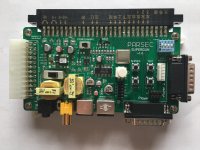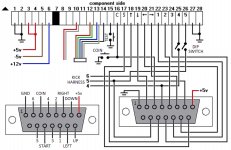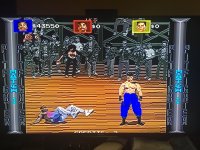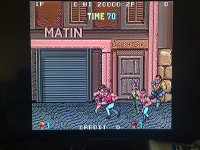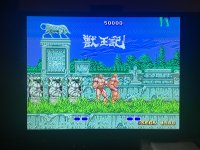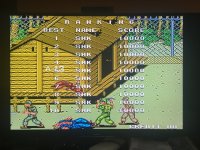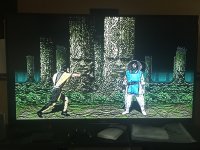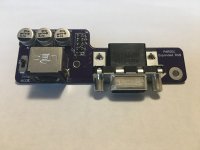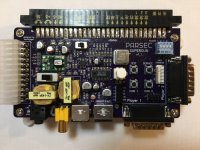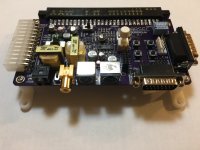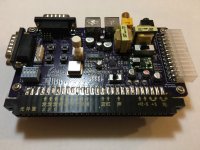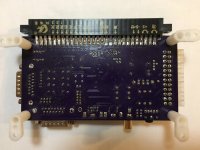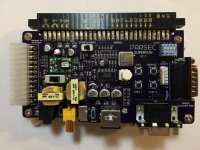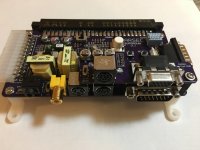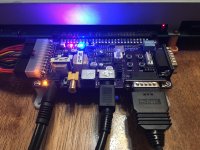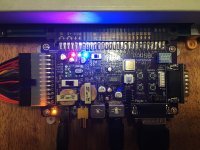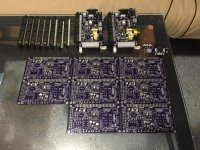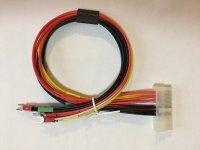low_budget
Student
Here is my attempt at designing a Supergun PCB, I call it the PARSEC. While I have built a number of superguns in the past, they used off the shelf video converters and were mounted in enclosures. I've designed and built many circuit boards over the years, including a RGB - NTSC converter board and the Super 8 bit game console, so I figured why not try a supergun project.
Testing and customer feedback so far has been great. Compatibility is looking pretty good. I'll post more pictures soon with different games.
The PARSEC is powered by a standard ATX power supply for PCs (not included.) Since newer ATX power supplies do not provide -5v, the PARSEC has an on-board -5v regulator so the JAMMA connector has the necessary +5v, -5v, and +12v for arcade games. An arcade power supply can also be used (by modifying an ATX power extension cable.)
PARSEC has a built-in NTSC video converter that provides composite and s-video as well as RGB output. A Sega Genesis 2 compatible A/V connector is used for RGB connection, and is compatible with all Genesis 2 A/V cables (even RF.) All outputs have 75 ohm drivers.
Audio line out is provided through a 1/8" stereo headphone connector or the Genesis 2 A/V connector. Since the signal from an arcade game is intended for speakers, this signal is attenuated to an amplifier safe level. Audio isolation transformers protect your TV or receiver.
Neo Geo compatible DB15 controller ports and kick harness connection header make the PARSEC compatible with 6 button games.
A 6 pin connector is included to make your own kick harness (soldering required.)
Features:
I've been offering these on www.tindie.com and ebay.
Price is $124.00 plus shipping.
I am working on a HAT board with VGA connector for RGB which I hope to have available soon as well.
Testing and customer feedback so far has been great. Compatibility is looking pretty good. I'll post more pictures soon with different games.
The PARSEC is powered by a standard ATX power supply for PCs (not included.) Since newer ATX power supplies do not provide -5v, the PARSEC has an on-board -5v regulator so the JAMMA connector has the necessary +5v, -5v, and +12v for arcade games. An arcade power supply can also be used (by modifying an ATX power extension cable.)
PARSEC has a built-in NTSC video converter that provides composite and s-video as well as RGB output. A Sega Genesis 2 compatible A/V connector is used for RGB connection, and is compatible with all Genesis 2 A/V cables (even RF.) All outputs have 75 ohm drivers.
Audio line out is provided through a 1/8" stereo headphone connector or the Genesis 2 A/V connector. Since the signal from an arcade game is intended for speakers, this signal is attenuated to an amplifier safe level. Audio isolation transformers protect your TV or receiver.
Neo Geo compatible DB15 controller ports and kick harness connection header make the PARSEC compatible with 6 button games.
A 6 pin connector is included to make your own kick harness (soldering required.)
Features:
- JAMMA, JAMMA+ compatible
- 24 pin ATX power input connector (also works with 20 pin ATX)
- Push button on/off switch
- On-board -5v regulator provides up to 1.5A
- Power on/off switch for -5v regulator
- LEDs indicating presence of +5v, -5v, +12v, and standby power
- Built-in NTSC video converter
- Genesis 2 compatible A/V connector for RGB video
- Composite video and s-video jacks
- 1/8" stereo line out jack or Genesis 2 A/V connector provides audio
- Genesis 2 A/V audio output disabled when 1/8" audio is connected
- Stereo / mono switch
- Audio attenuation circuit with isolation transformers
- Neo Geo compatible controller ports for players 1 and 2 with standard pinout
- Credit, test, and service buttons on-board
- Kick harness connector
- Buttons 4 and 5 on JAMMA connector can be disabled with DIP switches
- Basic button remapping option: credit and button 5 can be swapped by moving jumpers
I've been offering these on www.tindie.com and ebay.
Price is $124.00 plus shipping.
I am working on a HAT board with VGA connector for RGB which I hope to have available soon as well.

